If you own a classic muscle car made back in the ’60s or ’70s, you’ve probably become aware of an ironic problem: It is virtually impossible to find new performance tires for these old performance cars.
The BF Goodrich Radial T/A is about as good as it gets – and though it’s a good-looking tire, with handsome raised white lettering, like back in the day – the Radial T/A is not a performance tire. It’s a standard all-season radial with an “S” (112 mph) speed rating and tread designed for normal street driving.
And that’s about all there is.
Unless you change the wheels.
If you want a sticky-compound performance tire with an H (130 mph or better) speed rating.
Because no one makes them for the 14 and 15 inch wheels that classic-er muscle cars came equipped with from the factory.
Wheels this small are only found today – if you can find them at all – on small (and low-performance) cars.
A Prius has 15-inch wheels.
A Corolla is available with 17-inch wheels.
Modern performance cars like the new Mustang and Camaro and Corvette come with 18 and 19 inch wheels, at the smallest.
The long and short of it is that if you want to shoe your old performance car with modern performance tires, you will need to upgrade to larger wheels. Both diameter and width.
But that will change other things, including suspension geometry and ride height.
You may need to get new coil/leaf springs to restore the correct ride height and relationship of the body to the wheels/tires, etc.
Tire scrub is another possible problem.
The wheelwells of the ’60s and ’70s weren’t meant to accommodate the wheels and tires of the 2020s. You may find you can’t turn the front wheels to their maximum arc without bumping into something and both front and rear tires might get a shave every time you hit a bump.
Brake fit/performance is another possible issue – unless you also upgrade the brakes.
Before you contemplate such a swap, consult an expert and make it a package deal – or you could end up with a car that handles (and brakes) worse than it did with the factory 15×7 wheels and a set of 225/70-15 Radial T/As.
You’ll probably have to re-engineer the entire suspension system to get it to work right.
It will never look right.
As with ’60s and ’70s-era suspension geometry, the relationship of the car’s body lines and proportions to the size of the wheels and tires was based on the stance of 14 and 15 inch wheels – which were considered large wheels back in the day.
Also the relationship of the tire sidewall’s height relative to the wheel and both to the wheelwell. The sidewall height thing is the thing.
You can usually get away with a 16×8 wheel without hugely altering the look of a classic car but 17s and larger with ultra-thin sidewalls are obviously not from the ’60s or ’70s.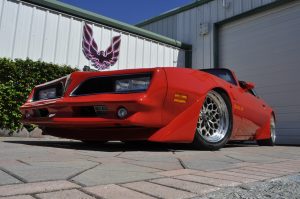
It’s not just a weird look.
It’s the same look.
Modern large diameter wheels look alike. They are generic – because they aren’t made for a particular car or brand of car but for as large a potential,market for them as possible.
They do not look brand-specific and that is something you will lose if you lose your classic car’s original wheels, which were as integral to the package as steering wheels – and brand-specific engines – once were.
Can you think of any modern wheel that is part of the car in the way that something like Pontiac’s ’70s-era Honeycomb wheel is?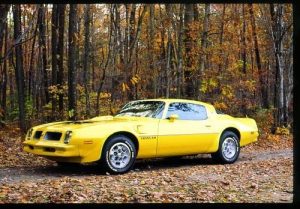
Most muscle cars came with factory wheels that defined the package and contributed greatly to making the car what it was.
What is a Shelby GT500 without its factory Magnum 500 wheels?
These wheels are small by modern standards, but they have big style – and history.
You throw them both into the dumpster when you take them off the car in favor of a set of look-alike generic rims that every modern performance car is riding on.
But that brings us back to the dilemma of finding performance tires – for the factory wheels – that are worthy of the capabilities of a classic muscle car.
Coker and other suppliers manufacture OE-type tires for numerous classic cars, including classic muscle cars. But while these are made to a higher standard than the originals, they aren’t performance upgrades. They are reproductions of what was made 40 or 50 years ago.
Which is a shame given that modern performance tire technology applied to a 15-inch tire would greatly increase the performance capabilities of classic performance cars – without mauling their classic appearance.
You could go faster, in the curves and straight ahead. You’d stop quicker. But the car wouldn’t look different. It’d be especially groovy if performance-compounds were used to make tires that looked classic. The original-style raised white lettering on a 130 MPH rated tire – which by the way is about as fast as classic performance cars were capable of going, their top speeds being mechanically limited by their gearing.
If you’d like to be able to buy a new performance tire to fit your classic performance car’s factory wheels, drop the tire companies a line and let ’em know.
The two most likely prospects are BF Goodrich and Goodyear, both of which used to make performance tires for old American performance cars (when they were new performance cars) but don’t make them anymore.
Maybe they will again, if enough of us ask them to.
. . .
Got a question about cars, Libertarian politics – or anything else? Click on the “ask Eric” link and send ’em in!
If you like what you’ve found here please consider supporting EPautos.
We depend on you to keep the wheels turning!
Our donate button is here.
If you prefer not to use PayPal, our mailing address is:
EPautos
721 Hummingbird Lane SE
Copper Hill, VA 24079
PS: Get an EPautos magnet or sticker or coaster in return for a $20 or more one-time donation or a $10 or more monthly recurring donation. (Please be sure to tell us you want a magnet or sticker or coaster – and also, provide an address, so we know where to mail the thing!)
If you’d like an ear tag – custom made! – just ask and it will be delivered.
My latest eBook is also available for your favorite price – free! Click here. If that fails, email me at EPeters952@yahoo.com and I will send you a copy directly!


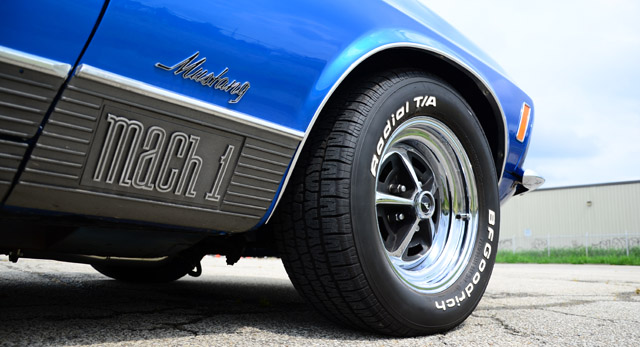

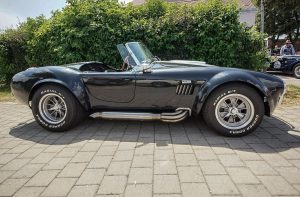
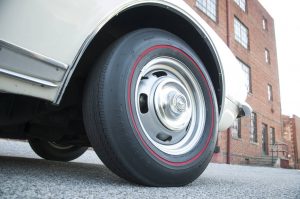







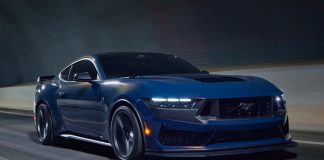
cokertire.com They buy the old molds for the vintage tires and are the go to place for vintage performance and reproduction tires.
Auric, looks like their prices are pretty good too. Thanks for the info!
Y.W. Mark….Car Bros stickin’ together!
The Coker Museum is also pretty interesting.
I spent a few hours there chatting with Corky Coker when I passed through Chattanooga one time.
but if you are willing to pay, he will make performance tires in that size.
So, I’ve not understood the modern phenomenon of big wheels. One, you see trucks driving around with what look like metallic wagon wheels and very thin tires. I’ll bet the ride in those is horrible.
But mostly, I’m perplexed by the other physical problem, that of inertia.
If we were to overly simplify and call your wheels “hoops”, the formula for moment of inertia would be I = MR^2, where M is mass and R is the radius of the wheel. So, let’s call the mass of the different wheels equivalent, for the hell of it (maybe new vs old alloys?). That would make the difference in inertia between 17″ and 15″ wheels [(17/2)^2]/[(15/2)^2] ~ 1.284. So the larger wheels have 1.284x the inertia of the smaller wheels, leading to a loss in acceleration performance and fuel efficiency, as well as increased brake wear. Now, I know car wheels aren’t hoops, and there may be angels or devils in the details, and maybe the weight of the car is a much greater concern, but it still doesn’t sit with me as sensible.
Your observations have merit. In competitive cycling, the single most advantageous component to cut weight to is the frame because that is usually where the most weight can be dropped with an upgrade and the part will last indefinitely without needing another replacement. The NEXT most advantageous component is the front wheel, followed by the rear wheel (for exactly the reasons you’ve outlined already). I have friends who race professionally and their sponsors will frequently buy them wheels costing $3000-7500 each because unlike the frame, the wheels are exhaustible parts. Like you said though, the devil is probably in the details with respect to cars. I would love to know if Eric knows anything more about this, especially since all the automakers have been driven mad with the emissions disease.
Haha, WOW, regarding the cost of those wheels! That’s sheer madness, though we all have different requirements. Also, regarding the “emissions disease”, haha… I used the “Ask Eric” feature of the site regarding an emissions-related issue. Does that actually work, because I noticed the “Previous Q & A” was “coming soon…”. And that’s not me being impatient, Eric, if it does work. Take your time. Just don’t want to be sending questions to the aether.
I believe that the “ask eric” does work, yes. At least it worked for me a couple years ago when I had a question. Regardless, he is likely to see your comment here anyways.
Hi Mark,
Yup – it works! Now, me, on the other hand…
One of the reasons for larger wheels is to fit larger brakes. Today’s performance cars are a lot more powerful than the ones sold 40-50 years ago which were frequently equipped standard with 14″ tires. Those old goats tended also to come standard with woefully inadequate brakes and tires. (Ever driven a fire-breathing old muscle car equipped with unassisted drum brakes and 14″ bias-ply tires? Scary!)
Given how much more massive a car is in relation to the wheels and tires than is the case with a bicycle I don’t know that the increased inertia of larger tires is very noticeable.
I see. And no, I’ve never driven anything like that. I’ve read of these “bias tires” you speak of in the ancient texts, though.
Many of those old muscle cars were all engine with very little chassis development; brakes and tires were barely an afterthought. The only concern was straight-line acceleration. Drive something like a stock ’65 GTO and (after you get out and are done kissing the ground) you’ll be happy your new 480hp Mustang has 19″ wheels and huge disc brakes to fit inside them!
Hi Jason,
This is true – in re the early GTO and other muscle cars having all engine and style and not much else. But that’s what made them fun! Very few people can drive a new Mustang – a base Mustang – anywhere near what it is capable of doing. The GT’s limits are much higher. In a way, this is less fun because the car is boring unless pushed well beyond what most people can safely deal with. This is part of the reason for all the saaaaaaaaaaaafety assists. Most people have never experienced driving sideways (and throttle steering) because the car’s adhesion limits are so high that if the car did break lose, the driver – most drivers – would lose it. So the car has technology to replace skill.
Even if you do know how to drive, the speeds required to really work a new performance car are so high as to entail a great deal more risk – on public roads – of something going wrong or something going AGW.
Oh, I know that, Eric! Style-wise I would certainly rather have a GTO than anything offered for sale these days. However I’ve driven cars that were equipped with big engines and undersized tires & brakes from the factory and it can be a white-knuckle ride – there is something to be said for a car that will stop as well as it goes! (I don’t think that detracts from the fun factor.) The point though was only that there can be legit reasons for larger tires.
It sounds like there is a hole in the market opening up for a company that only manufacturers custom and historic / collectors tires. Problem is, as people keep crashing or junking their old rides, the market keeps shrinking. I could see a made-to-order customize all the specs tire company coming about at some point in the future, but one or two of the existing tire giants would probably have to die off first. It would probably need to serve at least both historic and new exotic (and wouldn’t be cheap). Automation, fabrication, and logistics technologies have come about far enough to make this a reality, but it’s doubtful that crony capitalist / globalist mega corporations would execute such a business model — because, well — cui bono.
Doesn’t Coker Tire specialize in custom and historic tires? I think they even made custom tires for one of the surviving GM Futurliners some years ago. A quick search turned up this:
https://www.cokertire.com/blog/gm-futurliner-restoration-ron-pratte
My ancient ride is hardly a performance car (though it is V8 rear drive), and I changed from 14″ tires to 15″ because the selection of the smaller tires was becoming very limited, the larger cross-section sizes almost unobtainium. Now the 15″ sizes are becoming less common.
It’s kind of a moot point- there is really nowhere you can run them that fast in the USA. For a fun car, they are seldom driven at the limit. If they are driven to the limit, deficiencies in brakes, sway bars, and suspension geometry as well as cooling systems will rear their heads. Enjoy your muscle car- it was meant to be fun to drag race/street race, not be a modern supercar.
I’ve tried to make a silk purse out of a sow’s ear many times- one of my 49 Ford pickups has Jag XJS suspension, including the nice power 4 wheel disk brakes. This makes it very pleasant to daily drive in modern traffic. In no way do I have the cojones to run her up to the 140 or so the engine and drivetrain are capable of. My other F1 has the stock suspension- buggy springs, solid axles, and drum brakes. I’ve added power steering, and 15 inch radial tires (along with a 302HO and AOD). It rides rougher and the brakes are not as good, but it is still a fun toy and will still leave the stoplight in pleasant fashion.
I get where you’re going Eric, but I’ll bet the market is small.
Sorry Eric but I don’t agree. If one wishes for show quality originality or just wants his car to look as it did when it left the factory, he probably isn’t going to tax the limits of a tire rated above S anyway. One of the easiest ways to improve the handling of an older car is upgrading to Z, W or Y tires but that will involve changing to larger diameter rims. In my and a lot of other’s opinion, the aftermarket wheels of today look a whole lot better than the wheels of the 50’s – 70’s but if someone wants one of these original designs, there are a few companies making them in 17″ versions.
Hi Doug,
No need to be sorry! Everyone has a right to their opinion – and to do what they like to their car. I just wouldn’t do it to my car. Which I like for many reasons but one of the top ten is that it’s different from modern cars. Looks especially. And functionally, a good high-performance tire in a 15 inch size would markedly improve the car’s handling without altering its appearance or historical coolness.
If I had a classic, I’d just stay with the older wheel size and stick with Goodrich Comp T/A or similar. It is relatively safe to exceed 112 mph on those as long as you don’t plan on staying there all day.
Swamprat, I think, part of Eric’s point is that the direction things are heading yields a future without tires in those sizes altogether, regardless of their speed ratings.
My 68 Charger RT ran 10.03@133mph in the 1/4 with B.F t/a out front lol..Drag radial out back..Though if I stayed at 133 mph or faster on the highway I bet they would separate overtime..like my Satellite’s tires did when I was a kid!
Back in the early 90’s as a 17 year old I bought new 14″ tires for my 74 Satellite (road runner without the badging/hood scoop) 400 4bbl factory p code high performance it was quick,it beat up on 5.0 Mustangs of that era..But it was a beautiful highway car..I bought cheap new 14″ tires for it and after 1 month 3 tires separated..Then I would blast up to 110 – 120 MPH and sit there for several minutes on the straight highway here I worked nights,zero people on the road! I took the car back to the box store and they said those tires were rated for 90 mph lol…I somehow got a refund,went to the used tire store and bought some older Good Years and never had a problem with my 120 mph 17 year old highway driving! Yes,steady speeds for up to 10 minutes..That car I sold after 2 years and 0 problems besides the tires..I should have kept it..Oh Well,it’s one of 8 cars I shoulda kept lol..Yes I have the Charger still and a 72 Satellite cloned as a Road Runner!
Great stuff, XS!
In high school – back in the ’80s – a good buddy of mine owned a ’71 GTX 440 4 BBL with 14 inch Hurst mags… it was a fearsome thing to deal with at speed. But some of the best memories I’ve got!
I’m running BF Goodrich 60 series 195x 14 on my 69 Datsun roadster with 14″ Panasport rims (has the correct offset for a roadster). Bought the tires and rims 5years ago, So far so good.